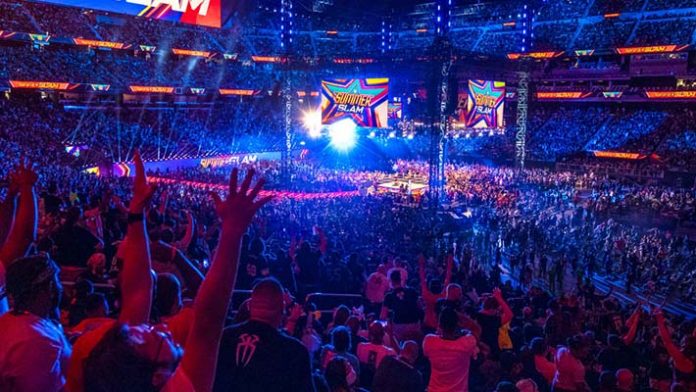
Recently, WWE has been in the news for what seems to be a revamp of their Premium-Live-Event schedule for 2023, something that has been largely welcomed by fans, myself included. A friend of mine suggested going into some of my thoughts, as I have been very vocal to many that I do not like the constant need to have a stipulation on a match because the calendar says its time, and I think this is a perfect time to dive a little more into this topic, what the benefits of it will be, and if there will be any harm to it as well.
In the late 1980s, WWE introduced the pro wrestling world to the Pay-Per-View market. While they have since rebranded them as Premium-Live-Events in 2022, the concept has remained the same since the early days of “the big 4”. In those days, you would have to wait several months before the next big card came around. TV and house shows were also big components of what furthered things in those days, and even into the 1990s, the PPV format remained largely untouched. As the decade wore on, and the rating war with WCW took centerstage in the wrestling business, the need for more frequent PPVs came about. At first, the concepts were largely just themed shows for the town they were in or who was in the card (such as the “In Your House” shows that routinely filled the months between the big 4). Then, some shows came about that became lasting and annual members of WWE’s calendar, such as “Backlash”, “No Mercy”, “Armageddon”, and “Judgement Day”, to name a few. These shows were always held in the same months each year, and they all served a purpose. Backlash was meant to be a fallout from Wrestlemania. Armageddon was first held in December 1999 while the Y2K conspiracies roamed wild and remained as an end-of-the-year event for a decade. These so-called “B shows” helped get storylines with bigger payoffs than on regular TV, and made money for the company both from ticket sales, but also PPV buy rates, which at the time were one of the statistics to watch. All in all, this was part of the reason WWE overcame WCW and saw such successes in the Attitude Era.
Things did begin to change in the Ruthless Aggression Era that was to follow that period. The 2002 brand split saw each brand assume the role of hosting their own monthly PPV, with them alternating months for several years. It always seemed like they tried to give Smackdown the shorter end of the stick, but they always produced, while Raw had many more miscues on the alternate side of things. They alternated many different shows while adding more for each show every month. They resurrected an old favorite from WCW in “The Great American Bash”, as well as bringing in “Vengeance”, “Cyber Sunday/Taboo Tuesday” and “New Year’s Revolution”. In this time period, each show was able to run shorter feuds and get their titles onto every card. There was, however, also a lack of depth to certain aspects of the shows, which saw many of them falter and resulted in the eventual end to the brand-exclusive shows, the combination of the cards, and monthly events with mostly the same names from the previous few years. In 2009, however, that’s when things took a turn for the worse.
2009 was the year when WWE started to double down on themed PPVs rather than the existing names in the mindset to shake things up and start drawing attention due to the name value rather than just the matches being offered. They had already kept the “Extreme Rules” concept in some fashion or another from 2005 onwards after the success of the one-off ECW show that year. Then they fluctuated that event throughout the year for the next decade-plus, being run in June, May, September, and July, to name a few of the months. Gone also were the traditional names of shows that lasted a decade, like “Unforgiven” and the aforementioned “Armageddon”, among others. In their place came the likes of the one-and-done “Breaking Point”, a new decade-plus long-running show in “Hell in a Cell”, the short-lived “Bragging Rights”, and soon after “Money in the Bank”. The lattermost of all of those I can excuse if I am being completely honest, as I have always viewed that show as the most fun one of all the gimmick PPVs of the last 13 years or so. While the match concept is very well-suited for a Wrestlemania card, it did fit nicely as a pre-Summerslam treat for many of these years in question. 2014’s MITB show led directly to the “Heist of the Century” of Seth Rollins at Wrestlemania 31, while Dolph Ziggler’s Raw-after-Wrestlemania 2013 cash-in remains one of the loudest moments in Raw history. Having those runs with the briefcases truly added to their cash-in, as the unpredictability of when they actually may cash in grew more and more every week. While these are several positives, the show also has suffered from uninspired booking, especially with the women’s briefcase in recent years, and seems to stall each and every year. Austin Theory seems directionless right now with the briefcase, and Otis/The Miz was a lost cause of a year with that one. Returning the match concept to Wrestlemania and replacing the show on the calendar is a great idea that could see much more intrigue around them once again and could give two superstars an instant must-watch feeling as WWE resets their calendar after the showcase of the immortals every year. Overall, I do think it’s best to go that route and allow some interesting matches to add to the Wrestlemania card instead of some pointless battle royals that nobody ever really cares about.
Let’s look now at some of these other gimmick shows, some of which truly run me up a wall. The one gimmick show that I believe should remain, as it is placed perfectly, is the “Elimination Chamber” event. This is a show that falls in the middle of the Road to Wrestlemania and is the perfect foil to anyone’s plans as they travel that road. When the show was removed from rotation in 2015, fans were outraged, and it was brought back very soon after and has remained a standard in the February calendar ever since. This match provides so many fun possibilities of who could head into the biggest show of the year either as a champion or a challenger to a title. Kofi-mania was born inside the Chamber. Bray Wyatt won his first WWE Championship in the Chamber, things that created some fun matches and shocking moments along the road happened there, and the match itself was already commonplace for at least 2 years under the “No Way Out” show in February prior to the name change for the show, so I give that one a pass. “Hell in a Cell” is one that has never made sense to me as a yearly event, s the match was created, in its infancy, to be a match that is the end to a deeply rooted, vengeful, hateful feud between two people who cannot stand one another. The feud ends there, inside the Cell, and the two don’t cross paths for some time. Think of all the prime examples of this: Triple H vs. Cactus Jack, Undertaker vs. Mankind, Triple H vs. Batista, Undertaker vs. Randy Orton, and the like. For as much as this show was meant to turn heads by getting people to want to see the structure and what it had become known for, it watered down the concept so much and took so much away from it. This isn’t to say that there haven’t been some bangers in there over that time. We did get the likes of Becky Lynch and Sasha Banks in 2019, Sasha Banks and Bayley in 2020, and of course, the 5-star classic that nobody will ever forget with Seth Rollins and Cody Rhodes at this past year’s event. For every one of those good ones, however, we got a Braun Strowman vs Roman Reigns and Seth Rollins vs The Fiend, the second of which is one of the biggest atrocities I have ever watched as a fan. They took so much away from what was once one of WWE’s most protected match stipulations, and although they have tried slightly to rectify it lately, it needs to no longer be a show and remain a stipulation to be the end all, be all of a feud.
One very interesting gimmick PLE that has been rumored to be returning is another one that was once a fan favorite and would also restore a very fun concept that fans want back annually. The King of the Ring was a staple of WWE for the better part of 2 decades until 2002, having its own PPV to host the tournament annually until Brock Lesnar won it in 2002. Then, save for one-off appearances in 2006, 2008, 2010, 2015, and 2021 (that year with the addition of the Queen’s Crown tournament), the concept has largely been dropped, and as mentioned, hasn’t had its own show in a very long time. Restore it, along with a female equivalent, will be so much more entertaining to fans who want to see the brackets play out. Restoring a title match to the winner(s) would be an even bigger added benefit to making people want to tune in.
So, with all of this said, it would look like WWE’s PLE schedule would resemble, more or less, the following, in 2023 and beyond:
Royal Rumble
Elimination Chamber
Wrestlemania
Backlash
King of the Ring
Summerslam
Evolution
A U.K. PLE
Crown Jewel
Survivor Series
Though not confirmed, this would be a major upgrade to the way WWE has done things these things over these past several years. It increases focus on the big 4, adds meaningful shows like KOTR and Evolution back to the rotation, and has a few unique “B-shows” to fill the in-between months that aren’t meant to drag down or force stipulations upon matches that are less deserving of it. “Clash at the Castle” in Wales this past September was so much fun, had a banger of a card from top to bottom and gave fans in the U.K. something they’ve wanted for decades. Doing that in place of something like Extreme Rules just makes more sense, because it allows so much more freedom and strays away from the box of stipulations for the sake of them.
Time will tell if this truly comes to pass, but here’s to hoping that it does, because I, for one, would be very happy if it does.
What do you think? Share your thoughts, opinions, feedback, and anything else that was raised on Twitter @PWMania and Facebook.com/PWMania.







